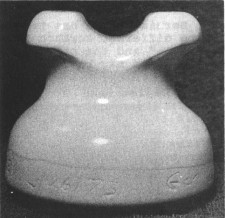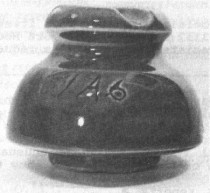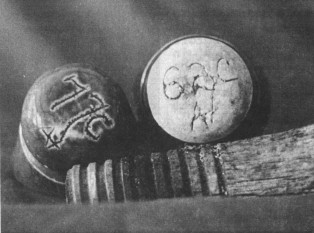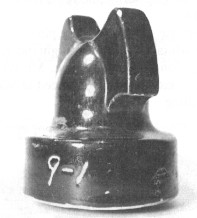Porcelain Insulator News
by Elton Gish, NIA #41
Reprinted from "Crown Jewels of the Wire", June 1989, page 7
Standard manufacturer markings which appear on unipart porcelain insulators
have been well documented, but occasionally odd handwritten markings are
reported on various insulators. Over the last few years I have received several
reports of these unusual markings. We now have enough of these reports to show
the variety that may be found.

Scott Janz reports a U-634A (see photo above)
with the I-T-E marking and a beautiful yellow glaze. You can see in the
photograph that the glaze does not cover the entire insulator, but stops just
above the scratched marking. The marking was scratched into the clay by hand
with a sharp instrument before firing, then dipped in paraffin to just above the
marking to prevent the glaze from covering the marking. The complete marking
is:

This is the best example that I have seen to indicate that these scratched
markings possibly refer to the testing of a particular glaze formula. This
insulator was apparently fired on 3/26/1973. The "EY" may refer to a
particular glaze formula. Other similarly marked insulators may turn up with
different letter codes. However, I suspect that most of the more modern
"test" insulators found their way to the dump rather than with a
customer's order. A number of older insulators with similar scratch markings are
known which indicate that some did find their way to active service.
A Fred
Locke U-608A in my collection (shown below) has a very large "1A6" scratched
on the side before it was glazed.

Bernie Warren has two ponies (shown below) with each having different scratch
markings. One of them is marked "77C / A+" and the other "62C / A+". Both insulators are very old and may be Fred Locke insulators.


Jerry Turner has a U-387 roman helmet (shown below) with the hand-written
marking "9-1". It also has the typical Locke marking shown above
which dates this insulator as being made between 1908-1922. What makes this
marking different is that it is not a scratch marking. It appears to have been
made with a wax pencil before it was glazed. The glaze would not adhere to the
wax, similar to the paraffin resist used on firing rests (and on the yellow
insulator), so the marking would then show after firing.

While most of the examples of hand-marked "test" insulators that we
have shown here were from Locke production, we cannot assume that other
companies did not similarly mark their "test" insulators. Locke, in
the early days, may have simply put their "test" insulators in with a
customer's order. After all, why throw a good insulator in the dump.
If you have
an insulator with similar "test" markings, please write to let us now
what you have. If we get a few more reports, we will show them in
"PIN". This is just another interesting part of collecting porcelain
insulators, and, when they come in yellow, so much the better. Right Scott?
| 